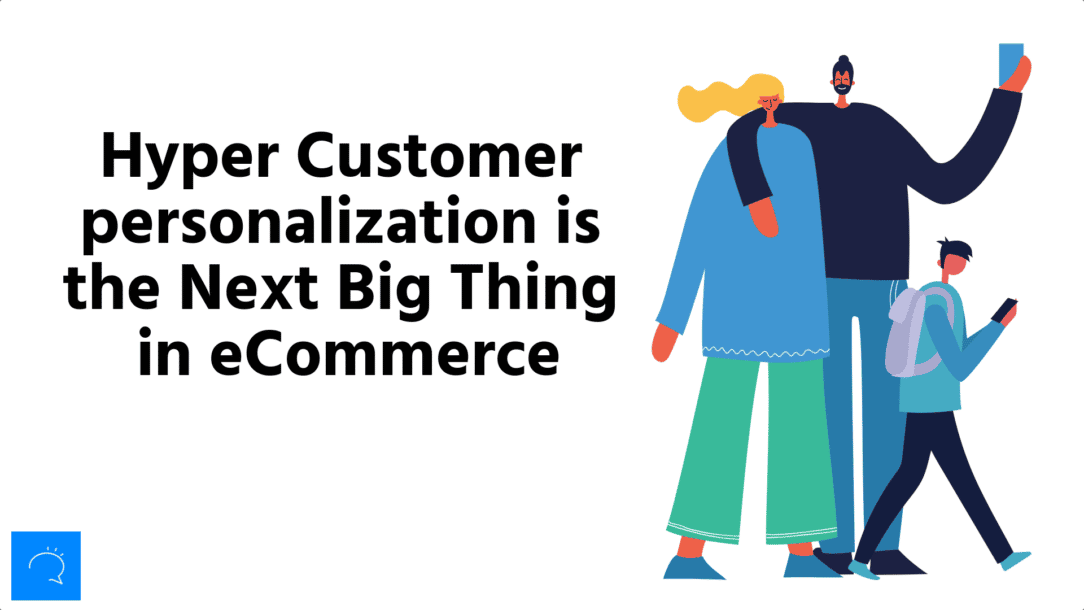Hyper customer personalization is the next big thing. Are you ready? Look, you’ve likely heard the phrase “it’s a small world” before. While it was originally coined in response to a children’s ride at Disneyland, it has since come to represent the idea that our world is getting smaller. Today, it’s easier than ever for companies to connect with their customers by speaking directly to them instead of talking at them. Last year has seen tremendous growth in eCommerce. In fact, global spending on e-commerce grew by 16% in the third quarter of 2020 already. With so much growth occurring in this space, it’s no surprise that companies are finding new and innovative ways to reach their customers, particularly through hyper-personalization.
Personalized marketing has become increasingly popular among e-commerce brands, particularly for retailers that want to improve how they engage with their customers. 80% of the customers will prefer a brand that provides a personalized experience. A significant percentage of consumers (76%) feel more positive about a brand after receiving personalized messages, and they are more likely to buy from that brand. Personalization is imperative and it has been proven over and over again that personalization can have a huge impact on your e-commerce business.
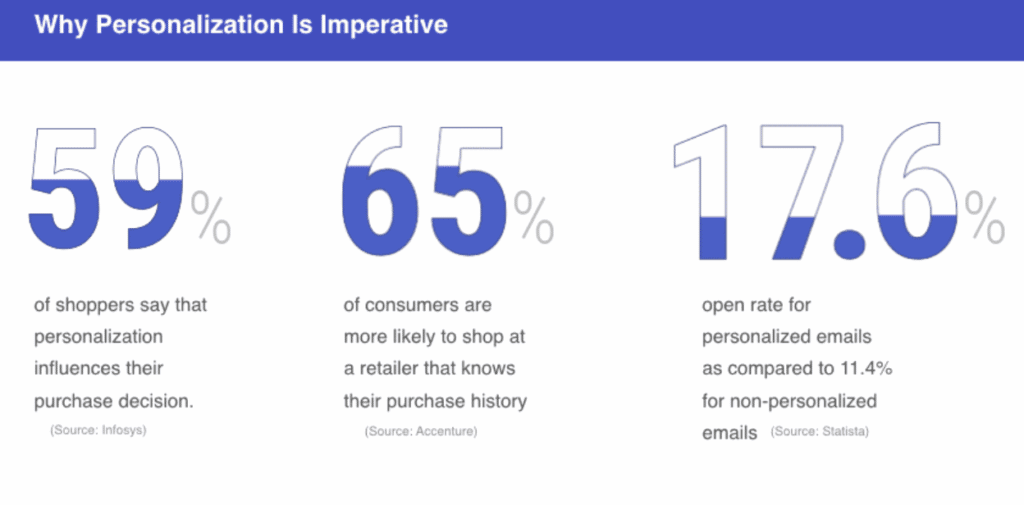
Source: WebEngage
But the question is, how can you introduce hyper-personalization into your marketing strategy to help improve customer engagement? If you want to improve your e-commerce business, hyper-personalization should be high on your list of priorities. Let’s look at how you can grow your e-commerce business with hyper-personalization.
First things first: what is hyper-personalization?
Personalization is nothing new in marketing, but it’s becoming increasingly relevant as companies strive to create a more personalized experience for their customers. Hyper-personalization can seem like a daunting term, but it’s really just a fancy way of saying “personalized marketing.” In fact, 90% of the retail market is using hyper-personalization to connect with the audience. Marketers who utilize advanced hyper-personalization get a $20 return on every $1 spent.
How can eCommerce use hyper-personalization?
As the world becomes increasingly digital, it’s easier than ever for companies to collect large amounts of customer data. The more you know about your customers; the more personalized your communication can be.
A few of the ways hyper-personalization can help you grow your eCommerce business include:
1. Provide a Personalized Experience on Your Business Website
With all of this customer data, companies can predict buying behavior based on customer preferences. For instance, you can use hyper-personalization to send out special offers or messages to customers who have shown an interest in certain products or categories on your site.
While you may have used personalization in the past with things like customized coupons or product recommendations, hyper-personalization takes it one step further by tailoring the entire customer journey, rather than just individual interactions.
For instance, if you land on an eCommerce website, you’ll likely see the same general message, like “Welcome to our site” or “Find your new favorite T-shirt.” The website uses AI to show you personalized products and messages based on your preferences and browsing history with hyper-personalization.
According to the insights from Salesforce, 66% of global consumers believe a brand must know about their needs and interests.
Example 1 – Stitch Fix:

StichFix Website
For instance, Stitch Fix, a famous clothing brand, uses AI to take quizzes from customers to personalize t(e product to their needs and interests.
This strategy results in higher conversion rates and better retention. When they have sufficient insight into the customer’s needs, they show them the more relevant products. They don’t bother the customer with irrelevant products, resulting in higher conversion rates and customer retention.
Example 2 – Skinkraft:

SkinKraft Website
Skinkraft is India’s one major skincare brand. They have taken AI hyper-personalization to the next level. Skinkraft provides a hyper-personalized experience for the users who visit their site.
They take a complete quiz regarding skin, skin type, and skin problems and generate a tailored solution. When you first land, Skinkraft gives you the option to explore information about your skin or hair. Next, they take basic demographic details. They will ask you for brief details about your hair and scalp, hair issues, and lifestyle to understand your current skin and hair needs.
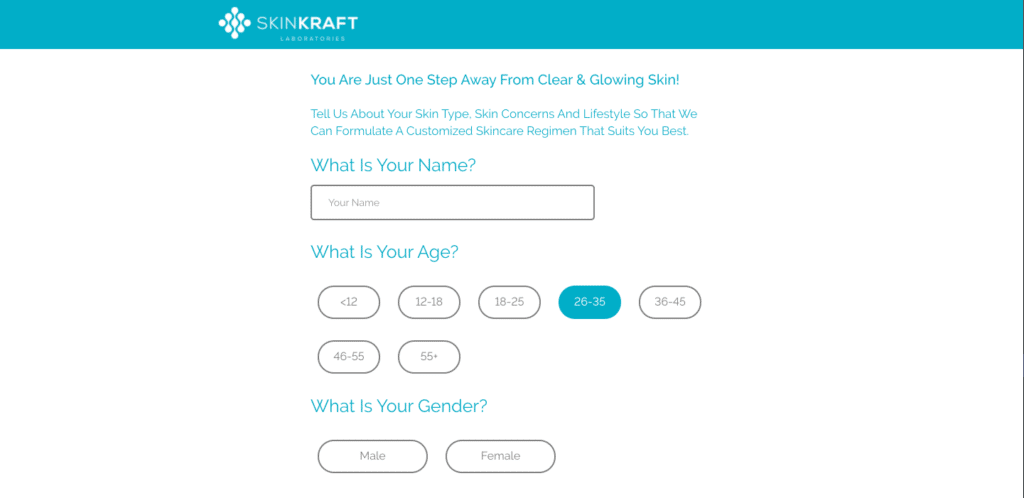
Taking Details
The most interesting thing about Skinkraft is that when you have completed the quiz, they offer you the chance to write a personalized name on your product and choose the color of the bottle you like.
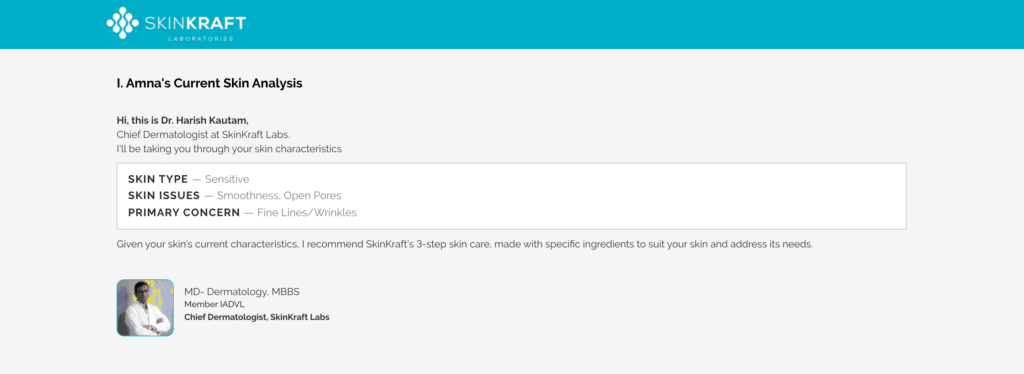
SkinKraft Results
This hyper-personalized solution makes customers loyal to the brand and gets them an effective care routine based on their varied needs.
2) Upsell and Increase Conversions
Personalized messages are more effective at increasing conversions. Customers are more likely to convert when they see messages that are personal and relevant to them. How can you increase conversions with hyper-personalization? More Relevant Messages If you know your customers’ needs and wants, it’s easier to send them the right messages. When you know what your customers like and don’t like, it’s easier to send them coupons and offers they’ll actually use. An example would be personalized emails you send to your prospects. When you send personalized emails to customers, your messages are more likely to spark their interest and increase engagement. For instance, if you are a travel agency and your customers buy airline tickets to New York, you can email them about cheap deals for hotels in New York. It will help you increase engagement with your customers and bring in more sales.
3) Increase Engagement:
When you talk to customers with hyper-personalized messages, they’re more likely to engage. For instance, let’s say you’re an online beauty product retailer. You have a group of people who have bought women’s perfume in the past but never bought men’s cologne. Then you send them a campaign with cologne and the right message. You’ll see more engagement from customers who’ve bought your men’s products before, and you’ll probably see a boost in sales as well. Industry leaders like Stitch Fix and Skinkraft use personalized messages to increase engagement and sales. The best part is that it’s not that difficult to implement hyper-personalization into your e-commerce strategy.
4) Decrease Shopping Cart Abandonment Rates:
Did you know that the average cart abandonment rate is almost 70% and e-commerce brands bear a loss of $18 billion every year? Cart abandonments are a major problem for any e-commerce business. Customers abandon their carts because they can’t find what they’re looking for or because the prices aren’t what they expected.
Check this graph of cart abandonment by industry:
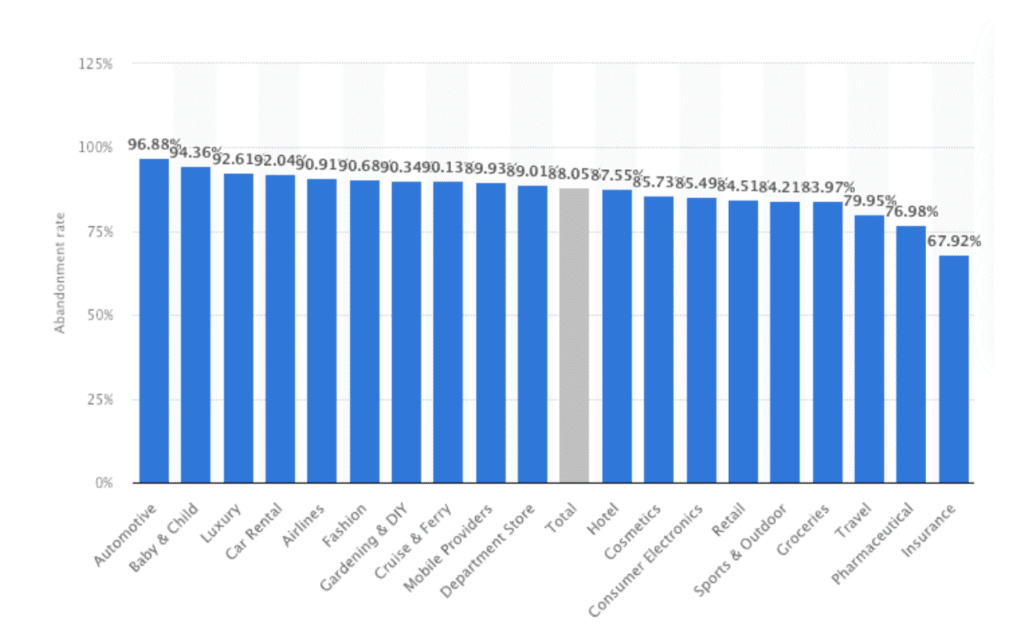
Cart Abandonments
There’s a reason why 84% of e-commerce marketers don’t follow up on abandoned shopping carts. They’re afraid of the “creepy line.” They worry that if they contact a customer after the first purchase, they will think that they’re being attacked and ignore them. However, you can’t ignore customers with abandoned shopping carts. You have to be willing to cross the creepy line and email them quickly. You have to find a way to get them back in the buying process.
This is where personalization comes in. Instead of addressing all your customers equally, start sending hyper-personalized emails to those who abandon their carts. You can find out why they abandoned their carts and then send them an email that provides solutions to the problems that caused them to abandon their carts. According to the latest insights, brands reported a 760% conversion rate after utilizing personalization strategies in cart abandonment emails. Emails like these can help you recover abandoned carts and draw customers back. Ecommerce businesses can recover an average of $50 per abandoned cart and increase revenue by up to 30% with personalized emails.
5) Increase the Lifetime Value of Your Customers:
The lifetime value is how much money you can expect to earn from them over time. Personalization is especially important for growing your e-commerce business because it can increase the lifetime value of your customers. For instance, let’s say you’re an online retailer specializing in women’s fashion. You spend $50 to acquire each customer, but the average value you get from each one is $200. Personalizing your emails to those customers can improve the lifetime value of each customer. With personalization, you can learn about your customers’ preferences and send them emails with products they’re more likely to buy. That means you’ll make more money from each of your customers.
6) Stellar Customer Service with AI-powered Chatbots:
In an oversaturated market, customers are looking for unique shopping experiences. Customers want retailers to provide them with benefits they can’t get anywhere else. One of the biggest problems that e-commerce businesses face is providing stellar customer service. There are simply too many customers to handle, emails, chat requests, and phone calls. Hyper-personalization is one of the most effective ways to give your customers a unique, engaging experience that will keep them coming back again and again.
It’s easier to grow your business when you have a high customer retention rate. Improved personalization in your chat support is one of the best ways to enhance the customer experience. As 96% of customers believe good and efficient customer service is crucial to increase loyalty to a brand. So, when you use AI to understand what your customers want, you can build a strong relationship. That’s where personalized AI-powered chatbots come in. Using chatbots for your e-commerce business can help you automate your customer service and increase conversions.
Chatbots augment human intelligence and let companies provide excellent customer support 24/7. When users interact with your brand and receive a highly personalized experience, they are more likely to feel valued and satisfied. For instance, if we take the example of Skinkraft, they use hyper-personalization to increase awareness and utilize AI-powered bots to provide quick and efficient customer service. The chatbot has answers to almost any question a user might have. So, instead of waiting for the staff to be available, they get immediate and quick solutions to their queries.
Example of Clepher’s AI-powered Chatbot:
Clepher goes the extra mile to ensure that your chatbots are customizable. You can upload your own logo and change the interface’s colors to match your brand’s colors. Clepher instills hyper-personalization in chatbots to help your customer base get what they want. For instance, check out this screenshot from Clepher’s personalized chatbot:
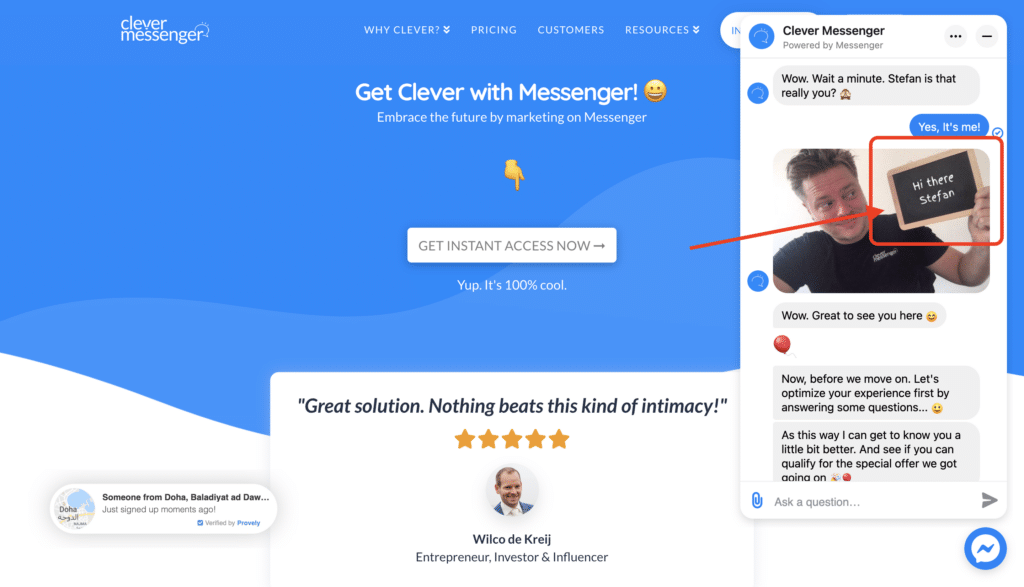
Clepher’s Hyper Customer Personalization
Such a personalized chat experience will surely help your e-commerce brand stand out from the competition and increase brand loyalty. Chatbots have become the next big thing in e-commerce customer service as they let you resolve more issues. Using chatbots is an even better solution because they let you automate most of your customer service. They can answer common questions, provide customer feedback, and quickly resolve customer issues. That means you’ll have more time to focus on your e-commerce business and generate more revenue.
How Can Clepher Help Your E-Commerce Business?
Clepher is a leading provider of AI-powered chatbots and 24/7 personalized customer support services. With the Clepher platform, you can monitor all your customer interactions in one place. You can use that information to provide better customer service and improve your marketing efforts. And of course, implement hyper customer personalization. For instance, the chat data you collect from your chats with customers can be used to gain insights into your target audience and their needs.
That will allow you to create more targeted content for your blog posts, e-zines, and ads. And that can help you generate leads and grow your e-commerce business. You have the option to schedule personalized messages for different time periods throughout the day. The scheduled personalization feature is excellent for marketing and promotional campaigns like you might use during your online shopping holiday events.
It doesn’t end here. You get 200+ chatbot templates that you can customize to suit your company’s needs. And, you don’t have to spend time creating a unique chatbot for each customer interaction. That’s right, you can simply choose a template that fits your brand’s tone and personality.
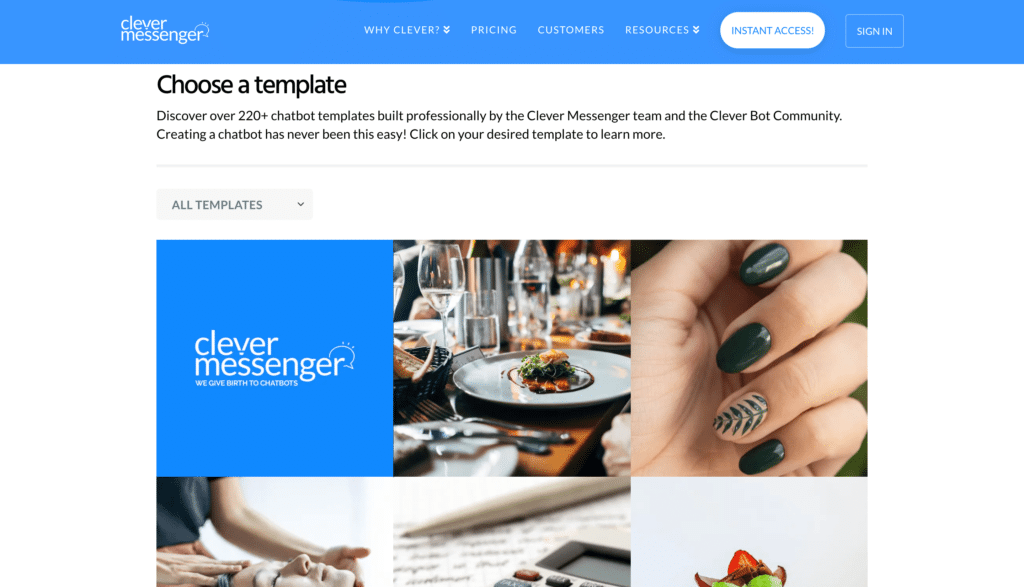
Chatbot Templates In Any Industry
Let’s Scale Your E-commerce Business
With Clepher, you get the right tools to succeed. So, if your e-commerce business is looking to grow with hyper-personalization, all you need to do is give Clepher a try. Check out the Clepher website for more information about personalized AI-powered chatbots for e-commerce businesses. Now you know how to grow your eCommerce business with hyper-personalization, and Clepher is here.
Related Posts

